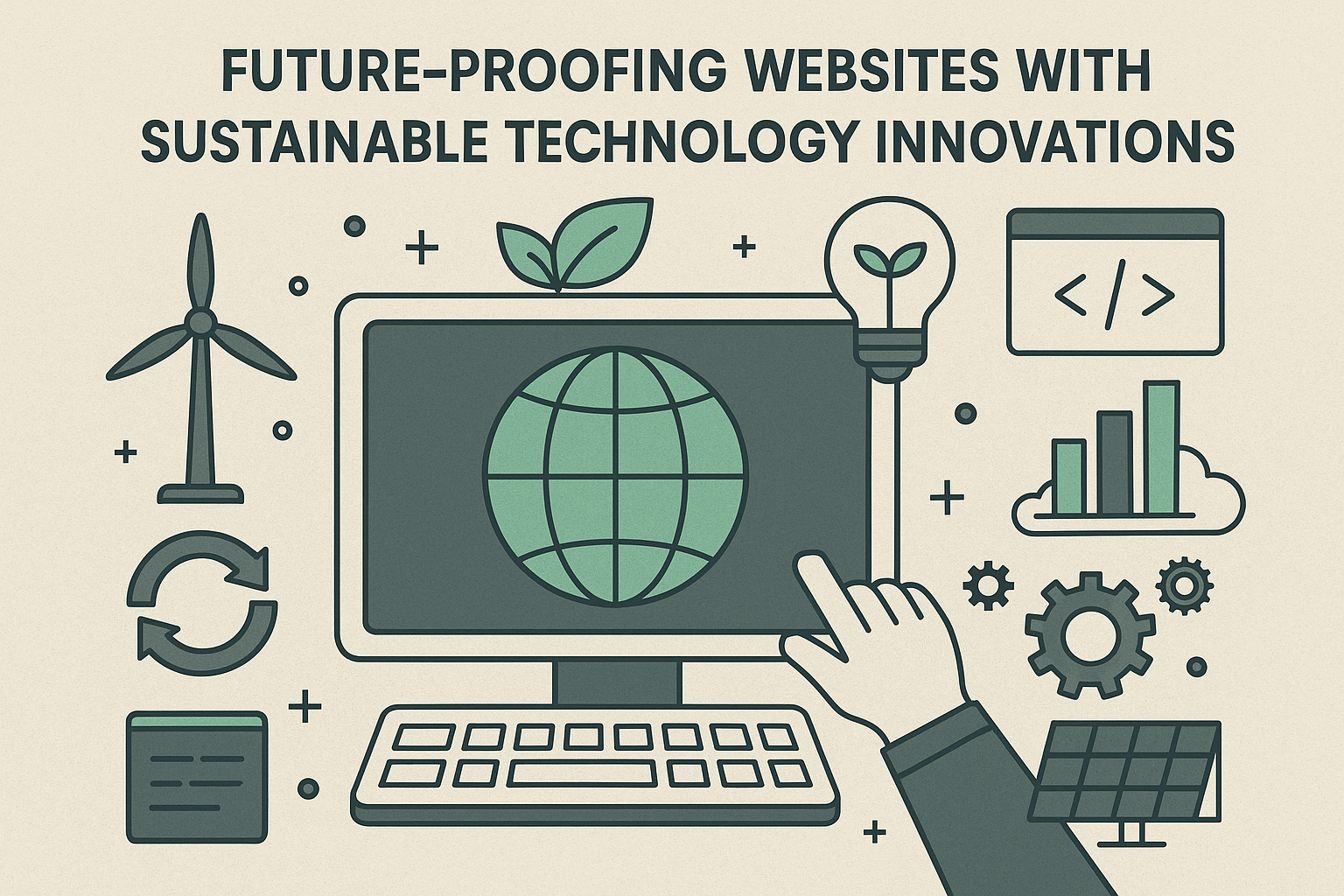Future-Proofing Websites with Sustainable Technology Innovations
Create a website that keeps up with digital changes to endure over time?
Numerous websites lose their relevance and become outdated shortly after their initial launch. This leads to:
- Poor user experience
- Decreased visibility in search engines
- Higher maintenance costs
But there’s good news! Implementing sustainable technology innovations lets you protect your website against future changes and support environmental responsibility.
In this article we will demonstrate the precise methods for creating websites which endure through time with reduced environmental impact.
What’s Inside:
- Why Website Sustainability Matters Today
- Key Technologies for Future-Proofing Your Website
- How Sustainable Tech Benefits Your Business
- Implementation Strategies for Long-Term Success
- Measuring Your Website’s Sustainability Impact
Why Website Sustainability Matters Today
Website sustainability requires digital assets to maintain their relevance, functionality, and efficiency throughout their lifespan.
Recent data from 2025 shows that 47% of Australian consumers choose sustainable products above cheaper alternatives demonstrating their increasing emphasis on eco-friendly practices.
Think about it:
The digital landscape changes rapidly. A digital solution that performed well five years ago could now operate with reduced speed, lack proper security measures or fail to meet modern standards. Future-proofing your website involves creating a structure that can evolve with technological advancements without necessitating total rebuilds every several years.
Sustainability requires more than following market trends. It’s about:
- Your website should operate using minimal computing power and energy while conserving bandwidth resources.
- Minimizing your digital operations’ carbon emissions to protect the environment.
- Long-term viability involves developing your site using technology and practices that will stand the test of time.
The best part? Sustainable practices will not only help the planet but also improve your financial performance.
Key Technologies for Future-Proofing Your Website
Creating a sustainable website requires the use of technologies that minimize environmental impact and guarantee long-term functionality. These are the essential technologies you should focus on.
Progressive Web Apps (PWAs)
Progressive Web Apps (PWAs) stand as one of the most transformative developments in the realm of website technology. Progressive Web Apps integrate the optimal features of standard websites with native app functionality to deliver:
- Offline functionality
- Faster loading times
- Reduced server load
- Lower energy consumption
Developing a website that operates like a native application enables you to minimize server request energy consumption while enhancing user experience.
JAMstack Architecture
The JAMstack approach to web development combines JavaScript, APIs, and Markup to transform traditional website building methods.
- Pre-rendering pages for lightning-fast loading
- Reducing server-side processing
- Minimizing database queries
- Allowing for simpler hosting solutions
This architecture minimizes computing resource consumption for website operation which enhances sustainability and future readiness. Expert website builders are increasingly turning to JAMstack for projects where performance and sustainability are priorities.
Serverless Computing
Serverless architecture enables application development and deployment without server management concerns. This means:
- Resources are only used when needed
- Automatic scaling based on actual usage
- No wasted energy on idle servers
- Lower operational costs
This approach allows you to utilize only necessary resources which leads to minimized waste and a reduced environmental footprint.
How Sustainable Tech Benefits Your Business
The adoption of sustainable technologies delivers real business advantages while supporting environmental protection efforts.
Improved User Experience
Websites designed for sustainability deliver quick load times and more fluid browsing experiences. This directly impacts:
- Bounce rates (fewer people leaving your site)
- Conversion rates (more people taking desired actions)
- Customer satisfaction and return visits
The numbers don’t lie: Seven percent fewer conversions occur when a website loads one second later than usual. When you focus on sustainable practices in building websites you end up with improved performance results.
Lower Operating Costs
Sustainable websites simply cost less to run:
- Reduced hosting requirements
- Lower bandwidth consumption
- Fewer resources needed for maintenance
- Extended lifespan before major rebuilds
High-traffic sites can achieve substantial savings quickly because even small optimizations produce meaningful improvements.
Better Search Engine Rankings
Top search engines like Google now prioritize excellent user experience websites which sustainable sites commonly achieve. The performance advantages of sustainable technologies directly affect your SEO because Core Web Vitals have become a ranking factor.
Australian companies will likely invest $1.5 billion into SEO services by 2025 according to reports which show growing digital marketing activities.
Implementation Strategies for Long-Term Success
Selecting the right technologies is straightforward but putting them into action effectively poses a different challenge. Follow these steps for strategic sustainable website development:
Start With an Audit
Before making changes, understand where you stand:
- Measure current page speed and performance
- Identify resource-heavy elements
- Analyze hosting efficiency
- Review code for obsolete or inefficient practices
By establishing this baseline you can focus on the improvements that will deliver the biggest results.
Choose Renewable Hosting
Not all web hosting is created equal. Look for providers that:
- Use renewable energy for their data centers
- Offer carbon-offset programs
- Implement efficient cooling and power management
- Provide serverless or auto-scaling options
Green hosting stands out as one of the easiest and most powerful actions organizations can take towards environmental sustainability.
Build for Longevity
Design decisions impact sustainability too:
- Implement enduring design principles instead of temporary trends.
- Use modular components which allow independent updates.
- Choose stable, well-maintained frameworks and libraries
- Document your code thoroughly for future developers
These methods help your website stay adaptable while being easy to maintain through technological change.
Incorporate Regulatory Awareness
Australian businesses now must include sustainability reporting within their annual reports as the Corporations Act 2001 (Cth) has been updated based on recent policy changes.
Building sustainable digital assets now helps you avoid compliance problems when new regulations take effect.
Measuring Your Website’s Sustainability Impact
You can’t improve what you don’t measure. To track the sustainability of your website use these essential tools and measurement metrics.
Performance Metrics
Performance metrics including Core Web Vitals demonstrate a strong connection to sustainability.
- Largest Contentful Paint (LCP): Measures loading performance
- First Input Delay (FID): Measures interactivity
- Cumulative Layout Shift (CLS): Measures visual stability
Higher scores generally demonstrate better usage of resources.
Carbon Calculators
Multiple tools like Website Carbon Calculator and Ecograder gauge your website’s environmental footprint by providing measurable data.
Resource Utilization
Regularly check page weight alongside the number of requests sent as well as server response time and CPU utilization. A reduction in these key metrics demonstrates more sustainable operational practices.
What This Means For Australian Businesses
Australian businesses experience both difficulties and prospects when working in the field of sustainability.
The New Vehicle Efficiency Standard (NVES), effective from January 2025, aims to reduce climate pollution from new cars by more than 50% by 2030 as reported, showing a broader push for cleaner technologies.
Getting Started Today
Ready to make your website more sustainable? Here are three simple steps to begin:
- Start with a baseline analysis of your website through Google’s PageSpeed Insights and the Website Carbon Calculator
- Reduce page load times by compressing your visual media because images and videos typically consume the most resources.
- Connect with website builders who focus on sustainable development methods.
Sustainability represents an ongoing process rather than an ultimate target. Each advancement provides benefits to environmental objectives as well as business outcomes.
Wrapping Up The Journey
Adopting sustainable technology for your website serves both environmental and business interests because it represents a smart investment strategy. You will achieve these benefits by implementing the discussed strategies and technologies.
- Reducing operational costs
- Improving user experience
- Preparing for regulatory changes
- Develop a company brand that appeals to today’s environmentally aware customers.
While the digital landscape keeps changing, sustainable websites will stay effective and relevant longer than standard websites.




